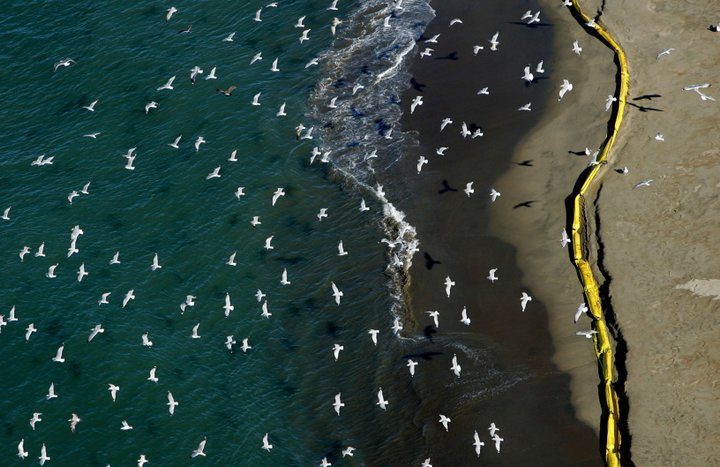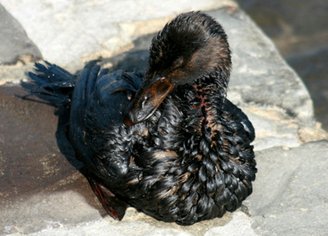
Birds fly over San Francisco’s Crissy Field East Beach, which was closed after a tanker spilled 54,000 gallons of fuel oil into the bay in 2007. California has stepped in to protect wetlands and birds. Photo by AP Photo/Jeff Chiu
###
On a foggy November morning, the 900-foot container ship Cosco Busan was lumbering through San Francisco Bay when it struck a support tower for the San Francisco-Oakland Bay Bridge. The collision gouged out a long scrape on the ship’s side, sending 54,000 gallons of sludgy petroleum billowing into the bay.
Heavy fuel oil slathered across 150 square miles, an estimated 7,000 birds died, as much as 30% of herring spawn died and 200 miles of coastline in five counties had to be cleaned up.
The penalties that followed the 2007 spill were prescribed by a federal law, the Migratory Bird Treaty Act, which has sheltered nearly every bird species in the nation for 102 years. The shipping company was fined $44.4 million, with more than $32 million set aside for rehabilitating birds and restoring their habitat, work that is still occurring.
But if that same disaster occurred today, the company would no longer be fined or prosecuted under federal law for killing birds. Under a 2017 Interior Department legal opinion issued by the Trump administration, companies are only penalized if they intentionally kill birds, a high legal bar.
To fill the void, California has stepped in with its own law.
It’s not the only federal rollback that has had repercussions on California’s environment: Parts of the powerful Clean Water Act were narrowed in April, when the Environmental Protection Agency stripped protections from many wetlands, a move that would allow development in ecologically sensitive areas.
In both cases, California officials have parried federal moves with actions of their own — a state law enshrining protection for migratory birds and a new state regulation setting definitions that expand protection to smaller wetlands and seasonal waterways.
California’s responses are yet another maneuver in the feud between Sacramento and Washington, D.C.
“It wasn’t difficult to see this coming or anticipate,” said Assemblymember Ash Kalra, a San Jose Democrat who authored the state bird protection law to ensure accountability for unintentional kills remained in place.
“Across the board, we must ask who the burden should fall on when it comes to protection of these critical environmental arenas,” Kalra said. “At the end of the day, should the cost of protection of our environment always fall on the taxpayers, when there are other responsible actors?”
“Puddle and ditch”
The changes to the federal Clean Water Act were a blow for California officials, who have been struggling to protect the remnants of wetlands after more than 90% have been lost in the state.
In California, many streams and ponds are intermittent or seasonal, which means there would be no safeguards under the new Trump administration’s definition of wetlands. Those so-called ephemeral waters, including creeks, desert playas and isolated pools, are a common feature in the arid West, where they provide valuable habitat for wildlife.
President Trump has long signaled his dislike of the broad reach of the Clean Water Act, promising he would rein in the law that he said afforded protection to every “puddle and ditch.”
Much of what the state will be preserving are unassuming areas, not the monumental landscapes that come to mind as worthy of safeguarding: Tidal flats, playas, seasonal pools and shallow non-vegetated ponds. Often such nondescript sites that are barren and dry most of the year are all-the-more valuable for their remarkable diversity of plants and animals.
The new federal definition could endanger the drinking water of more than 117 million Americans, according to a 2009 EPA analysis, which estimates that 58 percent of streams that supply public drinking water systems are intermittent or ephemeral.
The changes to the federal Clean Water Act could endanger the drinking water of more than 117 million Americans.
The Trump administration’s policy achieves an outcome that Trump often seeks — to undo an Obama-era policy. In this case, it unravels a 2015 rule that placed small bodies of water, often unconnected to larger ones, under federal jurisdiction and protection.
Last month, California and 16 other states sued to block the rollback. California Attorney General Xavier Becerra said the Trump administration is “once again on the wrong side of history, the wrong side of science, and the wrong side of the law.” The states are seeking a preliminary injunction against the rule, which is set to take effect June 22.
California also moved to put its own rule in place so there would be a seamless transition from federal to state protection.
“It was not designed in the beginning to be a backstop to changes the federal government was proposing,” said Jonathan Bishop, chief deputy director of water quality for the state Water Resources Control Board. “But as it got closer, it became clear that it was important for us to get this adopted and in place because the federal administration was making noise” about changing wetlands rules.
Wetlands, state officials say, provide shelter and food for more than 40% of California’s rare and endangered species.
California’s new polices open another front in the long-running conservation battle, which has mostly been confined to the courtroom; few states have mounted as many legal challenges to the Trump administration’s environmental cuts.
The state’s wetlands rules have been cheered by conservationists and met with blistering criticism from a spectrum of disparate interests: farmers, homebuilders, oil companies, wineries, dairies, private property owners, city and county flood control officials and the California’s High-Speed Rail Authority.
The opponents make the case that the regulations delay and drive up the costs of projects by redefining how development may dredge or fill wetlands.
“It is huge, it’s the most monumental change to the way we regulate wetlands that I’ve seen in my entire 20-year career,” said Justin Semion, a project manager for WRA, Inc., a California-based environmental consulting company.
Semion said that while it’s too early to quantify the impact on thousands of projects across the state, he estimates that the new state rules will add 25% to 50% to the cost of work in and around wetlands, especially for small and medium-sized businesses.
Millions of dead birds
Nationwide millions of migratory birds — including eagles, ducks, falcons, gulls and more than 1,000 other species — are killed every year by oil spills, construction, wind turbines, industrial waste ponds, large-scale solar projects and other operations.
Although the federal bird law has undergone many reinterpretations since it was enacted in 1918, it has always stated that it is “unlawful at any time, by any means or manner….to hunt, take, capture [or] kill…” migratory birds.
Industry lobbyists petitioned the U.S. Department of Interior in a campaign to weaken those protections. They found a sympathetic ear in Deputy Interior Secretary David Bernhardt, a former oil lobbyist.
Enter California’s law, enacted last September. The statute amends sections of the state Fish and Game Code, which had deferred for decades to the federal migratory bird law. The new state law emphasizes that California will enforce the ban on incidental or accidental killings or injuries, instead leaving of it to federal control.
State officials said they have not prosecuted or fined anyone under the new law yet.
North America has lost 30% of its adult breeding birds since 1970 from wetlands and forest loss, chemicals, pesticides and climate change, among other factors. In the face of that die-off, experts say, it’s the wrong time to eliminate bird protections.
“It’s alarming,” said Andrea Jones, director of bird conservation for the Audubon Society in California.

This surf scoter, a large sea duck, was covered in oil after the 2007 Cosco Busan spill in San Francisco Bay. Photo by Brocken Inaglory, Creative Commons via NOAA
California is well-acquainted with damage inflicted on birds from oil spills, in particular. The 1969 oil well blowout off Santa Barbara was credited with spawning the American environmental movement.
Another cautionary tale is the Deepwater Horizon explosion, which spewed more than 210 million gallons of crude oil into the Gulf of Mexico. The disaster imposed an incalculable toll on birds, owing in part to the near-impossibility of counting wildlife. The best estimates are that the spill killed more than one million birds.
And ten years later, the cleanup continues, fueled by a $100 million fine imposed by the provisions of the Migratory Bird Treaty Act.
Oil producers in California opposed the new state law, in part because of the lack of consistency between state and federal rules, said Kevin Slagle, a spokesman for the Western States Petroleum Association, an industry group.
But Kalra, the bill’s author, said that the fossil fuel industry eventually ratcheted back its objections. “They’ve already for 100 years been accustomed to operating with this treaty in effect and they have developed best practices,” he said. “This is not about telling them they cannot operate. Any suggestion of any additional regulatory burden just isn’t true.”
He said it was the large-scale solar industry that weighed in against his bill. Vast facilities such as the Ivanpah solar farm on California’s border with Nevada are injuring and killing as many as 6,000 birds a year, according to federal scientists.
Industry is often a culprit in bird mortality, but not exclusively. The California Coastal Commission in May charged the city of Long Beach with illegally destroying great blue heron nests during breeding season and killing at least one fledgling.
Under the California law, the extensive tree-cutting and trimming to reduce wildfire threats must be conducted with birds in mind. Utilities are required to prepare plans that avoid harming nesting birds and design power poles that discourage nesting.
Kalra said he is hopeful that the federal government will again partner with California and restore the nationwide protections.
“I hope that if there’s a change in administration, the federal government will rejoin the treaty,” he said. “We’ll see.”
###
CALmatters.org is a nonprofit, nonpartisan media venture explaining California policies and politics.
CLICK TO MANAGE